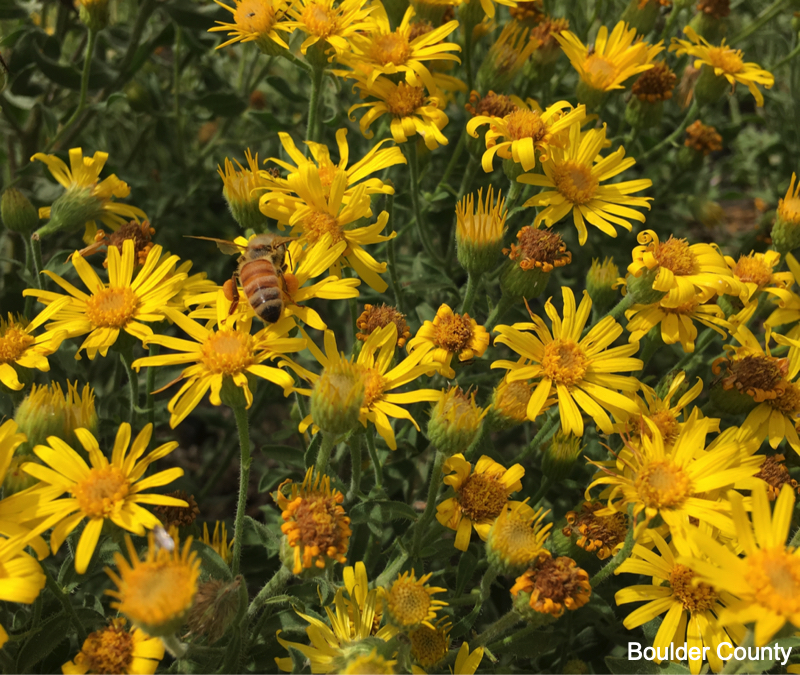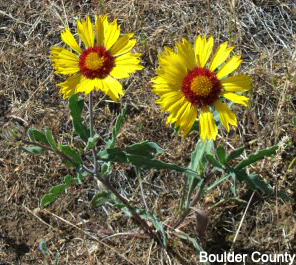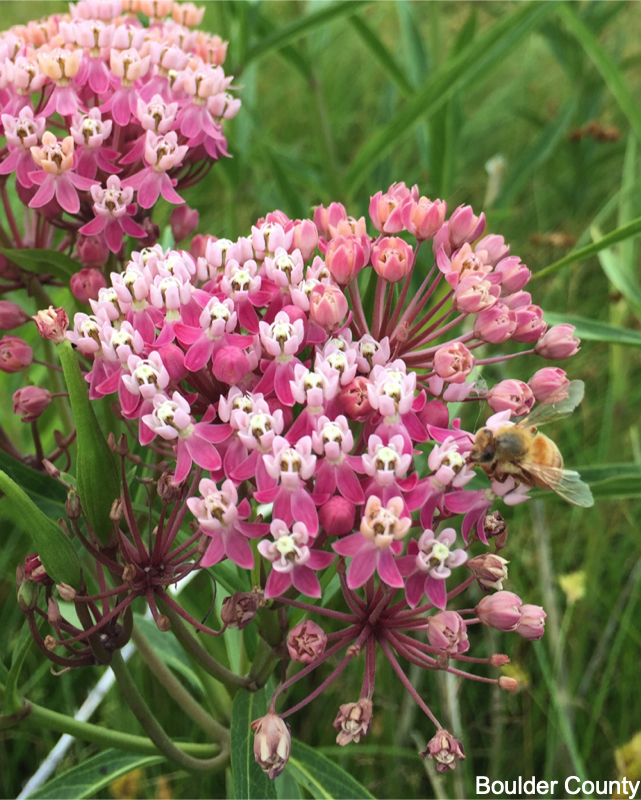By Deborah Lebow Aal
As you will recall, we have said many times that insects are half the show. We tend to try to get rid of them, especially if they are eating your prize roses, but remember that the only reason a plant flowers is to attract pollinators, mostly insects like bees. It’s a win-win if you start observing the insects as much as you observe the flowers.
We all know, love, and recognize the honeybee. We have many hive enthusiasts who are raising honeybees in their backyards. Great! But, there are 20,000 species of bees worldwide, of which the honeybee is only one, 4,000 bee species in North America, and 946 species right here in Colorado. There are a lot more bees out there than our non-native honeybees.

And, to knock your socks off even more, most bees do not live in hives. Only 10 percent of bees in the world are social bees. The other 90 percent are solitary. And 70 percent of those 90 percent live in bare, unmulched, ground. BARE GROUND. Did we know we had to leave some bare ground for those bees?
All bees are vegetarian. And, by the way, wasps bite, bees sting. Wasps are carnivores and are responsible for most of the “bee” stings out there. Bees die after they sting you, so they are loath to sting you unless you are really in their way. Unfortunately, there are bees that look like wasps and wasps that look like bees. Sigh.
What do bees need? They need food, water and shelter, just like you and me. They need a diversity of flowers that bloom throughout the growing season. They like bright white flowers, yellow and blue (just FYI, birds like red and orange, and butterflies like red and purple). They don’t like heavy mulch or grass. So, turf grass doesn’t help them out at all. They also need water – a shallow bowl will do.
All the bees – not just honeybees – are in decline. We have spoken of the insect apocalypse before. Some say more than 70 percent of the insect population is already gone. Their biggest problem, or predator, if you will, is humans. There are books like “The Bees in Your Backyard” that can tell you much more about what’s happening in the insect world, but there are many native plants that will provide what our native bees need. Native plants and native bees (or for that matter, native insects) co-evolved.* Here is a short list of native plants that you should plant to support the native bee population. I limited this to just a few to start, not to overwhelm you, and kept it to plants you should be able to easily find at local nurseries:
Early Season Bloom:
Pussytoes (Antennaria rosea): groundcover with sage green leaves and a white or pink bloom.

Sulphur buckwheat (Eriogonum umbellatum): groundcover with a small yellow flower
Pasque flower (Pulsatilla patens): gorgeous purple flower, very early blooming
Blue flax (Linum lewisii): bright blue flower. Blooms from May to August so it really could be in all three categories.

Mid-Season Bloom:
Aspen daisy (Erigeron speciosus): lavender flowers
Blanket flower (Gaillardia): yellow and orange flowers. Make sure to get the native – there are lots of varieties out there that are not.

Rocky Mountain Penstemon (Penstemon strictus): purple flowers
Yarrow (Achillea millefolium): our native one is white
Prairie winecups (Callirhoe involucrate): Gorgeous magenta flowers. Can take up a lot of real estate.
White evening primrose (Oenothera albicaulis): white (duh)
Giant sacaton (Sporobolus wrightii): a tall grass with long, narrow greenish blades
Late Season Bloom:
Common Sunflower (Helianthus annuus): yellow flower and quite prolific
Goldenrod (Solidago): yellow flower. (Note: I did an entire article on this plant because it’s such a good plant for pollinators)
Four o’clock: (Mirabilis multiflora): Deep pink flower. Can spread to be a pretty wide but low plant.
And, for a bonus, bushes that do well and are good for pollinators include chokecherry (Prunus virginiana), our native rose (Rosa woodsii), rabbitbrush (Chrysothamnus), and desert willow (Chilopsis linearis). Rabbitbrush can get a bit unwieldy. It’s not for folks who like very tidy gardens. Desert willow is my favorite, but it can get pretty tree-like and is native really to parts south of here, but does well here in protected spaces. Note that the first two like to form thickets, so they may not be good for small spaces.
One note is that none of these plants need or like lots of water or any additives to our native soil. They are all drought-tolerant, and you will most likely kill them with too much attention. And, please, please, please do not use herbicides and pesticides. They might kill the insect you dislike, but they will also kill beneficial insects. They are also not good for your own health.
This is just a snippet of information, of course. If you are interested, check out CSU extension for more information**. So, go forth and plant! And watch the show….

*There is ongoing research on whether native plants attract more bees and other pollinators than non-native species. There is also lots of insect observation that can be done in one’s own garden that we’d love to hear about.
** For much more information, check out “Bee Basics: An Intro to Our Native Bees,” a USDA, Forest Service, and Pollinator Partnership Publication. Efotg.sc.egov.usda.gov
Curious to learn more about transforming your garden into a habitat with Colorado native wildflowers, grasses, shrubs, and trees? Check out our native gardening toolkit, register for an upcoming event, subscribe to our newsletter, and/or become a member – if you’re not one already!
